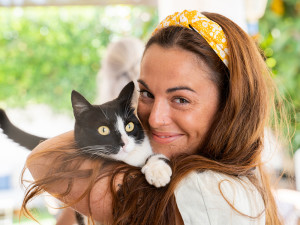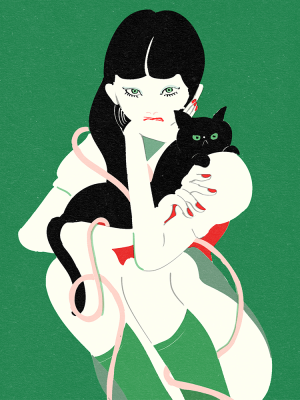
share article
Every cat parent knows the amusement of watching their pet trip out on catnip – rolling around in kittenish excitement with a catnip-stuffed toy, which the cat sucks and mauls and chews into a shapeless, saliva-soaked blob. Or you might sprinkle fresh catnip on your cat’s scratching post. When I do this, Chickpea, my own catnip-obsessive, starts out scratching but pretty quickly stops, hugs the cardboard scratcher, and starts licking the corrugation as though he were possessed and in the throes of love. Other times I’ll just toss some catnip on the floor, at which point he starts ecstatically flipping around in the crumbly green leaves like one might in an ocean of cash.
First of all, can cats eat catnip safely?
The answer is a resounding yes, absolutely. Not only is catnip safe for cats, but it can actually be good for their digestion and often works as an antidiarrheal. That said, try not to go overboard: too much catnip can cause temporary vomitingopens in a new tab, diarrhoea, dizziness and trouble walking. Take it slow and give your cat a little bit at a time.
The science behind catnip’s euphoria-like effects
Catnip is also called catmint, catswort and field balm, though I’m curious where and during which century. But what is catnip and how does it do what it does? “There are a few compounds in catnip that alter the behaviour of wild and domestic cats, but the main one that attracts cats is nepetalactone, and nepetalic acid is what gives most cats the high that we see,” says veterinarian Dr Sarah Dougherty. “They will experience euphoria-like effects, characterised by licking, chewing, and head shaking, followed by cheek and body rubbing. Spontaneous vocalisation can occur, which could be a response to hallucinations. A lot of people have also referred to catnip as an aphrodisiac for cats, and while the physiological response is not the same, some sexual stimulation is evident.” This would explain why young cats under the age of around six months, who haven’t yet developed those receptors, do not respond to it.
Catnip can mellow out stressed cats
Catnip can be not only highly entertaining, but also a godsend – a kind of natural feline Valium for demon cats such as formally feral Chickpea. We love him, but if one, say, interrupts one of his periodic plots to attack our other cat (a model of gentleness, the yin to Chickpea’s yang) he becomes a shrieking blur of fangs and claws. But just a pinch of catnip tossed on the ground in front of him and he collapses on his back with his paws flipped up like a giddy kitty, all homicidal and felicidal intent washed away in a blissful wave. Dr Dougherty confirms it can mellow out many cats: “Some veterinarians will recommend it to help manage separation anxiety and stress.”
Catnip doesn’t work for all cats
As much as Chickpea responds to catnip, our other cat, Koneko, doesn’t respond to catnip in the slightest. She’s not alone. “Studies indicate that only about 60 percent of cats will have a behavioural reaction to catnip,” explains Dr Dougherty. “This is because of a genetic component – a dominant trait must be present for the cat to have the correct receptors that lead to stimulation.” Happily there are alternatives. One is silver vine, a climbing plant common in Japan and China, which studies have shown may be even more potent than catnip and is available at pet stores or online. Valerian root is also commonly available.
Tatarian honeysuckle wood (which grows in abundance in the forests around our home) can also be used, though it’s vital to make sure that the honeysuckle being used is actually Tatarian, as other varieties are toxic to cats.
Interestingly, most felines, including big cats like leopards, lions and tigers, respond similarly to catnip. (Equally interesting: dogs are not affected.) It turns out there may be a survival function to catnip: nepetalactol has been proven to repel mosquitos (and the diseases they carry). If that last fact inspires you to grow your own catnip, I recommend sticking with the purchased variety. I tried once in our container garden in Los Angeles, but within a week, a mysterious interloper (I suspect a skunk) had devoured all of the mint-like leaves.
Catnip caveats
“Fresh catnip is more potent than the dried form,” cautions Dr Dougherty. “Too much catnip can cause health problems, such as vomiting, diarrhoea, dizziness or having trouble walking, so use just a little at a time. And avoid highly concentrated catnip oils due to their potency.”
On that note, while catnip looks kinda sorta like cannabis, I promise you, smoking it will not get you high. While catnip works for more than two-thirds of all cats, it works for exactly zero-thirds of all humans. The most you can hope for from your bid to light up your kitty’s stash is nausea and a particularly self-recriminating brand of headache. Not saying I know this from personal experience…

Robb Fritz
Robb Fritz is a writer, digital editor, producer, and content creator. He has previously written for McSweeney’s Internet Tendency where he penned a column entitled “History’s a Bitch: A Dog Walk Through Time.” He is now expanding his writing to include cats, which makes sense as he lives with two of them, along with his wife and daughter. They recently moved from LA to the much smaller town of Fairfield, Iowa, where they are surrounded by deer, geese, and a lot of cottontail.
Related articles
![A German shepherd and cat play affectionately in a bed.]() opens in a new tab
opens in a new tabThe Real Differences Between Cats and Dogs
There’s no winning this argument, but here’s what you should know about parenting each perfect pet
![a woman with black hair, green eyes, and red nails hugs a black cat]() opens in a new tab
opens in a new tabBlack Cats: Good Luck Charms Or Bad Omens?
Let’s dispel some silly superstitions
![a tattooed person with curly red hair on a couch pets a brown and black cat]() opens in a new tab
opens in a new tabCan Your Cat Smell If You’re Stressed?
And will they do anything about it if they do?
- opens in a new tab
Why Is My Cat Hiding?
No, they’re not on the lam. Here are four reasons your cat might be MIA





